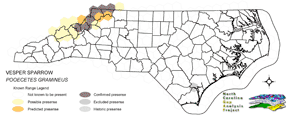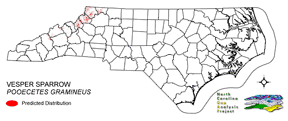
| Taxa: |
| Order: |
| Family: |
| Aves |
| Passeriformes |
| Emberizidae |
| NatureServe Global Rank: |
| NatureServe State (NC) Rank: |
| G5 |
| S2B,S2N |
| Federal Status: |
| NC State Status: |
| --- |
| SR |


| Land Unit |
| US Fish & Wildlife Service |
| US Forest Service |
| US National Park Service |
| US Department of Defense |
| NC State Parks |
| NC University System |
| NC Wildlife Res. Com. |
| NC Forest Service |
| NC Div. of Coastal Mgmt. |
| Local Governments |
| Non-Governmental Org. |
| Other Public Lands |
| Private Lands |
| GAP Status 1-2 |
| All Protected Lands |
| Statewide |
| Hectares |
| 0.00 |
| 849.78 |
| 0.00 |
| 1,061.46 |
| 19.44 |
| 3.42 |
| 23.67 |
| 0.00 |
| 0.00 |
| 10.44 |
| 116.91 |
| 27.99 |
| 49,978.26 |
| 1,217.25 |
| 2,081.70 |
| 52,091.37 |
| Acres |
| 0.00 |
| 2,099.85 |
| 0.00 |
| 2,622.92 |
| 48.04 |
| 8.45 |
| 58.49 |
| 0.00 |
| 0.00 |
| 25.80 |
| 288.89 |
| 69.16 |
| 123,498.95 |
| 3,007.89 |
| 5,143.99 |
| 128,720.55 |
| % of Dist. on |
| Prot. Lands |
| 0.0 % |
| 40.8 % |
| 0.0 % |
| 51.0 % |
| 0.9 % |
| 0.2 % |
| 1.1 % |
| 0.0 % |
| 0.0 % |
| 5.5 % |
| 5.5 % |
| 0.0 % |
| 0.0 % |
| 58.5 % |
| ----- |
| ----- |
| % of Dist. on |
| All Lands |
| 0.0 % |
| 1.6 % |
| 0.0 % |
| 2.0 % |
| < 0.1 % |
| < 0.1 % |
| < 0.1 % |
| 0.0 % |
| 0.0 % |
| < 0.1 % |
| 0.2 % |
| < 0.1 % |
| 95.9 % |
| 2.3 % |
| ----- |
| ----- |
|
Birds breeding in North Carolina represent those on the southern-most extreme of the speciesĘ summer range (A.O.U. 1957). They are thought to nest south to Haywood (Potter et al. 1980) and Buncombe Counties, mostly along the Unaka Mountains and on 'adjacent transverse ranges' at middle to high elevations (Simpson 1992). Have nested at Greensboro,
Rocky Mount, Wilmington (Potter et al. 1980), Blantyre (Transylvania County), Blowing Rock (Pearson 1959), Mitchell, Avery, and Watauga Counties, and as far south as Henderson County, on the South Carolina Border (Simpson 1978). Moderate to steeply sloping open fields with short grass, including heavily grazed fields, (see Knight 1997) grassy balds (Simpson 1992) and cultivated fields (hay, wheat, corn stubble of previous year) (Potter et al. 1980, Rising and Beadle 1996). Habitat requires perches available for singing, such as trees at the edge of the field or the tops of shrubs (Rising and Beadle 1996). Nest is often built in a depression dug in the ground near areas of bare earth or sparse vegetation (Rising and Beadle 1996). It is placed at the base of a clod of dirt (Rising and Beadle 1996), sparse shrub or herbaceous plant, which often grows denser as the season progresses (Potter et al. 1980). The birds feed on the ground, sometimes scratching with both feet simultaneously (Rising and Beadle 1996) NATURE SERVE GLOBAL HABITAT COMMENTS: Plains, prairie, dry shrublands, savanna, weedy pastures, fields, sagebrush, arid scrub and woodland clearings (AOU 1983). In Iowa, breeding territories were along fencerows between agricultural fields (Rodenhouse and Best 1994). Nests on the ground, often in a small depression near a clump of grass (Harrison 1978). |
| Code | Name | Description | NC Natural Heritage Program Equivalent |
| 180 | Agricultural Crop Fields | Farm fields used for row crops. | No equivalent |
| 205 | Agricultural Pasture/Hay and Natural Herbaceous | Farm fields used for pasture grass or hay production, as well as old fields dominated by native and exotic grasses. | No equivalent |
| 202 | Residential Urban | Includes vegetation interspersed in residential areas. Includes lawns, mixed species woodlots, and horticultural shrubs. Vegetation accounts for between 20 - 70% of the cover. | No equivalent |
| 523 | Grassy Bald | High Elevation grassy balds including Pennsylvania sedge, mountain oatgrass, as well as shrubby areas dominated by Alleghany and smooth blackberry. | Grassy Bald |
|
Adams, J. S., et al. 1994. Survival and growth of nestling vesper sparrows exposed to experimental food reductions. Condor 96:739-748.
American Ornithologists' Union. 1957. Check-list of North American birds. Fifth edition. American Ornithologists' Union. Port City Press, Inc. Baltimore, Maryland. 691 p. (Reprinted in 1961 by Port City Press, Inc., Baltimore, Maryland.). Simpson MB Jr. 1992. Birds of the Blue Ridge Mountains. Chapel Hill and London: University of North Carolina Press. Rodenhouse, N. L., and L. B. Best. 1994. Foraging patterns of vesper sparrows (Pooecetes gramineus) breeding in cropland. Am. Midl. Nat. 131:196-206. Simpson, M.B. Jr. 1978. Breeding season distribution and ecology of the Vesper Sparrow in the southern Blue Ridge Mountain province. Chat 42:1-2. Knight, R.L. 1997. Vesper Sparrow. Pp. 342-343 in Nicholson CP. 1997. Atlas of the breeding birds of Tennessee. Knoxville: The University of Tennessee Press. 426 p. Skutch, A.F. 1996. Orioles, blackbirds, and their kin. A natural history. Tuscon: University of Arizona Press. 291p. Pearson, T.G. 1959. Birds of North Carolina. Raleigh, NC: Bynum Printing Company. Rodenhouse, N. L., and L. B. Best. 1983. Breeding ecology of vesper sparrows in corn and soybean fields. Am. Midl. Nat. 110:265-275. Harrison, C. 1978. A field guide to the nests, eggs and nestlings of North American birds. Collins, Cleveland, Ohio. Potter, E. F., J. F. Parnell, and R. P. Teulings. 1980. Birds of the Carolinas. Univ. North Carolina Press, Chapel Hill. 408 pp. Terres, J.K. 1980. The Audubon Society encyclopedia of North American birds. Alfred A. Knopf, New York. American Ornithologists' Union (AOU), Committee on Classification and Nomenclature. 1983. Check-list of North American Birds. Sixth Edition. American Ornithologists' Union, Allen Press, Inc., Lawrence, Kansas. Pylypec, B. 1991. Impacts of fire on bird populations in a fescue prairie. Canadian Field-Naturalist 105(3):346-349. |
For more information please contact them at:
NC-GAP Analysis Project
Dept. of Zoology, NCSU
Campus Box 7617
Raleigh, NC 27695-7617
(919) 513-2853
www.basic.ncsu.edu/ncgap